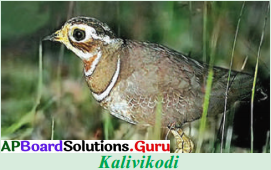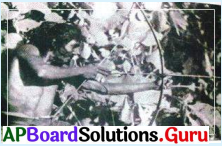These AP 7th Class Social Important Questions 2nd Lesson Forests will help students prepare well for the exams.
AP Board 7th Class Social 2nd Lesson Important Questions and Answers Forests
Question 1.
How many climatic regions are there in the world?
Answer:
There are seven climatic regions in the world.
Question 2.
Write the names of climatic regions.
Answer:
- Equatorial climatic region
- The Savanna
- Desert Region
- Mediterranean climate
- Steppe climate
- Taiga
- Tundra Climate
Question 3.
Define the following terms : i) Flora ii) Fauna
Answer:
i) The term flora is used to denote plants of a particular region or period,
ii) The term fauna is used to denote the species of animals
Question 4.
Where are the Mangrove tidal forests found?
Answer:
The Mangrove tidal forests are found in the areas of coasts influenced by tides.
![]()
Question 5.
When do trees of the tropical deciduous forests shed their leaves?
Answer:
Trees of these forests shed their leaves in dry summer.
Question 6.
Name some of the commercially valuable trees that grow in the tropical deciduous forests.
Answer:
Teak, Sal, Bamboo, Rosewood, Sandalwood, etc.
Question 7.
Which type of vegetation grows in Thorny forests?
Answer:
Cactus, Acacia and thorny bushes grow in Thorny forests.
Question 8.
Give the location of Evergreen forests.
Answer:
The Evergreen forests are found in heavy rainfall areas of Western ghats, North Eastern states and Himalayan region.
Question 9.
What are the common animals found in the Montane forests?
Answer:
The common animals found in the Montane forests are Musk deer, Snow leopard, Wild sheep, etc.
Question 10.
Mention the wild life found in the Deciduous forests.
Answer:
The common animals found here are Deers, Hares, Elephants, Tigers, Leopards, Peacocks, etc. .
Question 11.
Define forest.
Answer:
A forest is a piece of land with many trees.
Question 12.
Write any tw« features of Tundra region.
Answer:
- Extremely coid climate
- Low biotic diversity
![]()
Question 13.
What does Taiga mean?
Answer:
A moist subarctic forest dominated by conifers.
Question 14.
How many types of forests are there in Andhra Pradesh?
Answer:
Forests in Andhra Pradesh are mainly divided into four types.
- Moist deciduous forests
- Dry deciduous forests
- Shrub forests
- Tidal forests
Question 15.
Where are the moist deciduous forests found in Andhra Pradesh?
Answer:
These forests spread over the agency areas of Srikakulam, Visakhapatnam and East Godavari.
Question 16.
What are the important trees in dry deciduous forests of Andhra Pradesh?
Answer:
Maddi, Teak, Billu, Egisa, Neem and Red Sandal trees, etc.
Question 17.
Where are the shrub forests found in Andhra Pradesh?
Answer:
These forests grown in YSR Kadapa, Kurnool, Anantapur and Chittoor districts.
Question 18.
Which are the important tribes of Andhra Pradesh?
Answer:
Bondo, Chenchus, Konda Reddies, Konda Savaras, etc.
Question 19.
In which year forest department was established by British govt, in India?
Answer:
Forest department was established by the British in 1864.
Question 20.
Define deforestation.
Answer:
Clearing of forests over a wide area is called deforestation.
Question 21.
Define social forestry.
Answer:
Social forestry is the managerpent and protection of forests and afforestation in barren and deforested lands, for the purpose of helping environment social and rural development.
![]()
Question 22.
Write the climate regions and type of Natural vegetation in them.
Answer:
The impact of climate on natural vegetation of the following regions.
| Climatic regions | Type of Natural vegetation |
| 1. Equatorial regions | Dense forests with tall trees. |
| 2. Savannas | The areas are turned from dense forests to wide grasslands. |
| 3. Desert Regions | Very less trees with thick barks and small leaves or no leaves at all. |
| 4. Mediterranean climate | Broad leaf evergreen trees are found here. |
| 5. Steppe climate | The natural vegetation is grass and scrub |
| 6. Taiga | Evergreen coniferous forest. |
| 7. Tundra Climate | Not support for the growth of trees. |
AP Board 7th Class Social 2nd Lesson 1 Mark Bits Questions and Answers Forests
I. Multiple Choice Questions
1. There are ……………. climatic regions in the world.
A) 1
B) 4
C) 7
D) 5
Answer:
C) 7
2. Equatorial region dense forest is called as
A) Savannas
B) Selvas
C) Downs
D) Pampas
Answer:
B) Selvas
3. The tribals of Amazon basin
A) Pigmies
B) Gypsies
C) Red Indians
D) Bantus
Answer:
C) Red Indians
4. Which is the largest desert in the world?
A) Kalahari
B)Thar
C) Gobi
D) Sahara
Answer:
D) Sahara
5. What is the most important commercial activity in Taiga region?
A) Fur trading
B) Grass trading
C) Bark trading
D) Meat trading
Answer:
A) Fur trading
6. Forests are divided into …………….. types based on climate, rainfall and types of soils
A) 4
B) 6
C) 5
D) 3
Answer:
C) 5
7. Evergreen forests are located in
A) Himalayan Region
B) Peninsular plateau region
C) Coastal areas
D) All the above
Answer:
A) Himalayan Region
![]()
8. Lion – tailed macaques are in
A) Deciduous forest
B) Evergreen forest
C) Mangrove forest
D) Desert forest
Answer:
B) Evergreen forest
9. Sandal wood trees are in
A) Thorny forests
B) Montane forests
C) Deciduous forests
D) Evergreen forests
Answer:
C) Deciduous forests
10. Sundarbans are in
A) West Bengal
B) Goa
C) Uttar Pradesh
D) Haryana
Answer:
A) West Bengal
11. These are known as Swamp forests
A) Mangrove forests
B) Thorny forests
C) Deciduous forests
D) Montane forests
Answer:
A) Mangrove forests
12. Bramha Jamudu, Naga Jamudu are in
A) Montane forests
B) Thorn forests
C) Deciduous forest
D) Evergreen forests
Answer:
B) Thorn forests
13. Musk deer and Snow leopards are common in
A) Plateau region
B) Plain region
C) Desert region
D) Himalayan region
Answer:
D) Himalayan region
14. In which year National Forest Policy Act implemented?
A) 1988
B) 1980
C) 1952
D) 1956
Answer:
C) 1952
15. Which state has largest forest cover in India?
A) Andhra Pradesh
B) Jarkhand
C) Chhattisgarh
D) Madhya Pradesh
Answer:
D) Madhya Pradesh
![]()
16. Which state has lowest forest cover in India?
A) Punjab
B) Goa
C) Haryana
D) Asom
Answer:
C) Haryana
17. The area of India is
A) 3.28 m.sq
B) 2.38 m. sq
C) 4.05 m.sq
D) 5.37 m.sq
Answer:
C) Haryana
18. Which district has highest forest cover in Andhra Pradesh?
A) Krishna
B) Y.S.R. Kadapa
C) Nellore
D) Prakasam
Answer:
B) Y.S.R. Kadapa
19. Which district has lowest forest cover in Andhra Pradesh?
A) Krishna
B) Guntur
C) Kurnool
D) Anantapur
Answer:
A) Krishna
20. Which is the largest forest in Andhra Pradesh?
A) Seshachalam
B) Simhachalam
C) Nallamala
D) Yerramalla
Answer:
C) Nallamala
21. The coastal length of Andhra Pradesh is
A) 974 km
B) 1000 km
C) 978 km
D) 872 km
Answer:
A) 974 km
![]()
22. Forest department was established by British in
A) 1988
B) 1888
C) 1864
D) 1852
Answer:
C) 1864
23. How much % of forest area is required to maintain ecological balance ?
A) 20%
B) 33%
C) 28%
D) 53%
Answer:
B) 33%
24. Where is Royal Bengal Tigers found?
A) Mangrove forests
B) Montane forests
C) Thorn forests
D) Tropical evergreen forests
Answer:
A) Mangrove forests
![]()
25. Deciduous Forests grow in areas with rainfall between
A) 100 cm to 200 cm
B) 75 cm and 200 cm
C) 150 cm to 300 cm
D) 80 cm to 120 cm
Answer:
B) 75 cm and 200 cm
II. Intext – Bits – Fill in the Blanks
1. The equatorial forest is located between …………. and ……………. of equator.
2. The rainfall of Tropical climatic region is ……………..
3. Pigmies in ……………. basin.
4. The Savanna grasslands are located between ……………. and …………… of equator.
5. The livelihood of the Savanna grasslands people is ………………..
6. Natural vegetation of Sahara desert has ……………….
7. Olive, cork-oak trees are grown in ………….
8. Extensive agriculture is practiced in ……………… region.
9. The Tundra region stretch between and …………… and ……………… regions.
10. People of Tundra Climate are depending on ……………. for their food.
11. The temperature, rainfall, soil are the main factors determine the type of ……………. in an area.
12. Mahogany, ebony are in ………….. forests.
13. Rosewood, Sandalwood and Neem are in forests.
14. Total area under forest and tree cover in India is ………….. sq. km.
15. Andhra Pradesh has a forest cover area of ………….. sq.km.
16. The most important tree in Seshachalam forest is …………… .
17. Chenchu tribals are in …………. forest.
18. DST stands for …………….
19. OTFD stands for …………….
20. Forest Rights Act was passed in ……………… year.
21. Forest Conservation Act was passed in ……………
22. National Forest Policy was announced in …………….
23. Deforestation is the …………….. of trees in a large area.
24. Forest department was established by British in ……………
25. Mongoose, Eagle, are in ……………. forests of Andhra Pradesh.
26. Tumma, Balusu, Regu are found in …………… forests of Andhra Pradesh.
Answer:
- 5° and 10° North and South Latitudes
- 150 cm
- Congo
- 10° to 20° North and South Latitudes
- Cattle grazing
- Thick barks and small leaves or no leaves
- Mediterranean climate
- Steppe climate
- The Arctic and Polar
- fauna
- vegetation
- Evergreen
- Deciduous
- 8,07,276 sq.km
- 37,392 sq.km
- Red Sandalwood
- Nallamala
- Forest Dwelling Scheduled Tribes
- Other Traditional Forest Dwellers
- 2006
- 1980
- 1952
- Cutting
- 1864
- Tidal
- Shrub
III. Match the following
1.
| Group-A | Group-B |
| 1. YSR Kadapa | A) Shrub forests |
| 2. East Godavari | B) Deodar |
| 3. Srikakulam | C) Vegi, Egisa |
| 4. Himalayan Region | D) Jittegi & Sal |
Answer:
| Group-A | Group-B |
| 1. YSR Kadapa | A) Shrub forests |
| 2. East Godavari | C) Vegi, Egisa |
| 3. Srikakulam | D) Jittegi & Sal |
| 4. Himalayan Region | B) Deodar |
2.
| Group-A | Group-B |
| 1. 5° to 10° N & S | A) The Savannas |
| 2. 10° to 20° N & S | B) Taiga |
| 3. 20° to 30° N & S | C) Tundras |
| 4. 55° to 70° N & S | D) Desert region |
| 5. Poles | E) Equatorial |
Answer:
| Group-A | Group-B |
| 1. 5° to 10° N & S | E) Equatorial |
| 2. 10° to 20° N & S | A) The Savannas |
| 3. 20° to 30° N & S | D) Desert region |
| 4. 55° to 70° N & S | B) Taiga |
| 5. Poles | C) Tundras |
3. Andhra Pradesh.
| Group-A | Group-B |
| 1. Forest cover | A) Krishna |
| 2. Coastal line | B) YSR kadapa |
| 3. Highest forest cover | C) 22-94% |
| 4. Lowest forest cover | D) Visakhapatnam |
| 5. Highest density of forest cover | E) 974 kms. |
Answer:
| Group-A | Group-B |
| 1. Forest cover | C) 22-94% |
| 2. Coastal line | E) 974 kms. |
| 3. Highest forest cover | B) YSR kadapa |
| 4. Lowest forest cover | A) Krishna |
| 5. Highest density of forest cover | D) Visakhapatnam |
Do You Know?
7th Class Social Textbook Page No. 21
→ For administrative convenience, the Government of India divided forests into three types. They are:
- Reserved forests.
- Protected forests.
- Unclassified forests.
1. Reserved forests :
These are the forests where the activities like hunting, grazing etc. are prohibited and the rights of this land are reserved with the government.
2. Protected forests :
They are intended to protect certain species of flora and fauna. Excessive damage is not allowed here.
3. Unclassified forests :
No restrictions on collection of forest products for livelihood and grazing of cattle in these forests.
7th Class Social Textbook Page No. 23
According to Indian State Forest Report (ISFR) 2019.
Total area under forest and tree cover in India is 807,276 sq. km. That is 24.56% of the total area. In the global position of forest area, India ranks at 10.
7th Class Social Textbook Page No. 26
Red sandalwood is one of the rare species grown in Seshachalam forest in the districts of Kadapa and Chittoor. It has a prominent place in the economy in terms of production.

Kalivikodi that lives in Sree Lankamaleswara abhayaranyam in Kadapa district has been notified as rarest species by IUCN (International Union for Conservation of Nature and natural resources).
7th Class Social Textbook Page No. 27
Chenchus are an aboriginal tribe whose traditional way of life is based on hunting and gathering. They speak Chenchu language. We can see them in Nallamala forest.

The British, who ruled India before independence, enacted two laws in 1864 and 1878 to establish the Forest Department and hand over control over the forests. The laws restricted the traditional/customary rights of the tribals and forest users by classifying forests as ‘reserved’ and ‘protected’ forests. Reserved forests were forests in which no one could enter. ‘Protected’ forests could be used by people; they could take head-loads of wood and, small forest produces for their own use and could graze their cattle.
But, here too, there were many restrictions over cutting trees, grazing more than the limit set by the Forest Department, etc. The national forest policy 1988 declared that the primary task should be to associate the tribal people in the protection, regeneration, and development of forests.
Now the Govt, of Andhra Pradesh has started Eco-tourism, an initiative-taking tip for the creation of new community-based Ecosystem centers and strengthening the existing eco-tourism centers by involving local tribes in Andhra Pradesh.
7th Class Social Textbook Page No. 29
| Year | Act / Incident |
| 1894 | The Forest Law |
| 1950 | Forest Festival |
| 1952 | National Forest Policy |
| 1980 | Forest Conservation Act |
| 2006 | Forest Rights Act |
